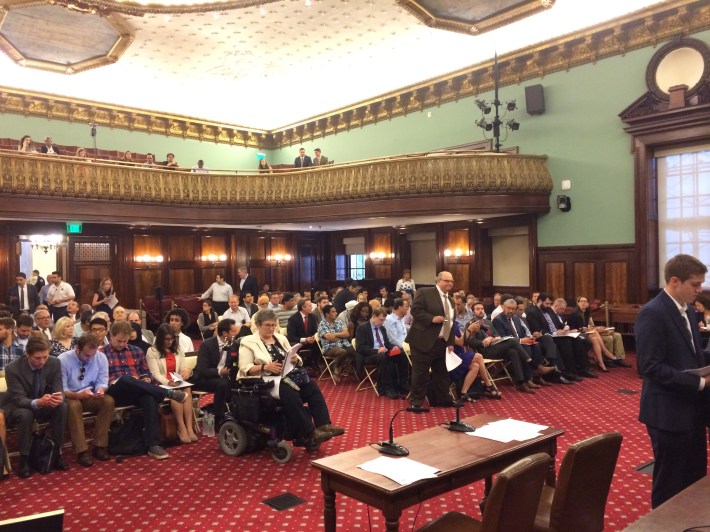
The de Blasio administration made its case for temporarily restricting the growth of licenses for ride-hailing services like Uber at a City Council hearing this morning. With congestion in Manhattan getting worse, City Hall's plan is to cap the number of new for-hire vehicles on city streets for the next year while it studies the impact of the industry on traffic.
Today, the city splits most car services into two categories: medallion yellow taxis and for-hire vehicles (FHVs), which include green boro taxis, livery services, limousines, and drivers for companies like Uber and Lyft. Each has different rules and regulations.
Yellow cabs, which are the only service subject to a surcharge that helps fund the MTA, are limited by the number of medallions. The number of boro taxis, which are supposed to pick up passengers outside the central areas of the city, is capped by state law. But the city has no mechanism to limit the number of black cars, hence City Hall's need for legislation introduced in the City Council by Transportation Committee Chair Ydanis Rodriguez and Steve Levin.
Since the advent of Uber and other app-based services, the number of FHVs on city streets has boomed, growing 63 percent since 2011. Nearly three-quarters of trips made by the new FHVs originate in Manhattan south of 60th Street, according to DOT, and the city is worried that these trips are a major factor behind the recent increase in congestion in the center of the city, which in turn may explain why bus ridership is dropping faster in Manhattan than in the outer boroughs.
"This decrease in traffic speeds is happening at the same time that overall traffic into the Manhattan CBD has fallen," said Transportation Commissioner Polly Trottenberg. While traffic in 2014 was 9 percent slower in the Manhattan central business district than it was in 2010, the number of vehicles entering the CBD each day had dropped 6 percent over the same period. The implication: The spike in for-hire cars circulating Manhattan has more than offset the reduction in other vehicles driving into the city center.
The city is looking to slow the growth of new for-hire vehicle licenses as it studies their impact on traffic. While the focus is on for-hire vehicles, Trottenberg said the study will look at a variety of issues affecting congestion in the Manhattan core.
This led Council Member Dan Garodnick to ask whether the new 25 mph speed limit or bike lanes could be contributing to the slowdown in Manhattan traffic. Council Member Carlos Menchaca asked if bike-share could be a factor. "We’re going to look at every factor. We’re going to take a look at everything," she said.
Ultimately, however, the study's focus is on creating a new regulatory regime for car services.
TLC Commissioner Meera Joshi left the door open when a reporter asked if the city will be eliminating the distinctions between medallions and other car services. “I can’t rule that out," she said after the hearing. “From a consumer’s perspective, that’s the way it’s going to look, and the regulatory and legal frameworks behind that may eventually mirror what consumers see.”
“We’re in an era of blurred lines," Joshi said, referring to the industry upheaval caused by e-hail apps. "Those lines are becoming less important because the way people get cars is becoming more similar regardless of the color of the car they get. And the conduct of the cars is really the same. They’re gonna all congregate where passenger-rich densities are, and that’s in Manhattan.”
The audience at today's hearing was large and included a number of medallion industry interests who were determined to secure a cap, temporary though it may be, on new competition from black cars.
Uber, meanwhile, opposes the cap and testified against the bill. The ride-hailing service has grown to 18,858 affiliated cars and six livery bases. Vehicles at those bases would be subject to a 1 percent growth limit until the city completes its study or the end of August 2016, whichever comes first. (Smaller for-hire bases, which outnumber the large bases, would be able to grow at a faster rate over the same period.)
Exchanges between council members and Uber, which recently targeted bill sponsor Levin in an email alert to its customers in his district, quickly became testy at today's hearing.
After a particularly tense back-and-forth with Uber's Michael Allegretti over the company's impact on car ownership and transit use, Council Member Brad Lander fired back. “I don’t think your sarcasm is helpful here,” he said. “What I am interested in doing is trying to make sure we develop a regulatory model for a system that’s in system shock, that’s in dramatic transition. And that has real consequences."





